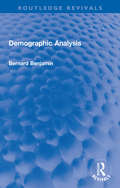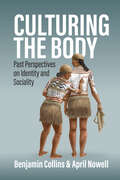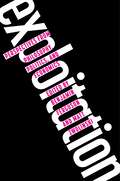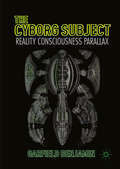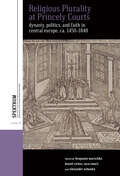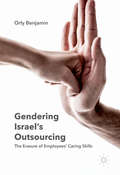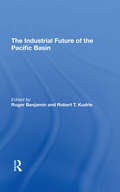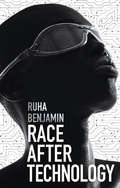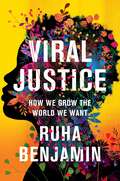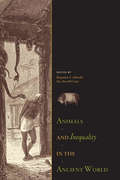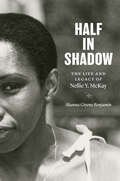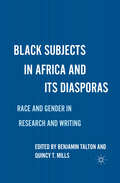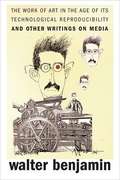- Table View
- List View
Demographic Analysis (Routledge Revivals)
by Bernard BenjaminFirst published in 1968, Demographic Analysis was written to provide a comprehensive account of demographic methods for those with a need to understand population movements. The book provides an introduction to some of the key tools used by demographers and the principal sources of population data. Beginning with an overview of the scope, content and use of the population census, it then examines methods for measuring births, deaths, and migration before setting out the methodology for determining the contributions of these elements to population change and estimating past or future changes. The book also explores sickness as a population characteristic and a way of better understanding mortality variations.
Demographic Analysis (Routledge Revivals)
by Bernard BenjaminFirst published in 1968, Demographic Analysis was written to provide a comprehensive account of demographic methods for those with a need to understand population movements. The book provides an introduction to some of the key tools used by demographers and the principal sources of population data. Beginning with an overview of the scope, content and use of the population census, it then examines methods for measuring births, deaths, and migration before setting out the methodology for determining the contributions of these elements to population change and estimating past or future changes. The book also explores sickness as a population characteristic and a way of better understanding mortality variations.
Culturing the Body: Past Perspectives on Identity and Sociality
by Benjamin Collins and April NowellThe human body is both the site of lived experiences and a means of communicating those experiences to a diverse audience. Hominins have been culturing their bodies, that is adding social and cultural meaning through the use pigments and objects, for over 100,000 years. There is archaeological evidence for practices of adornment of the body by late Pleistocene and early Holocene hominins, including personal ornaments, clothing, hairstyles, body painting, and tattoos. These practices have been variously interpreted to reflect differences such as gender, status, and ethnicity, to attract or intimidate others, and as indices of a symbolically mediated self and personal identity. These studies contribute to a novel and growing body of evidence for diversity of cultural expression in the past, something that is a hallmark of human cultures today.
Exploitation: Perspectives from Philosophy, Politics, and Economics
by Benjamin Ferguson, Matt ZwolinskiExploitation: Perspectives from Philosophy, Politics, and Economics brings together recent work on the topic of exploitation from philosophy, political science, and economics in one volume, organized around three main questions: What is exploitation? Why is exploitation wrong? What should we do about it? These questions are increasingly relevant in public policy discussions. The past decade has witnessed the rise of populism and an increasing sense that politics is a game rigged to benefit certain classes of persons at the expense of others. Interestingly, this sense of unfairness has been shared across the political spectrum though, of course, the left and right differ in both their moral diagnosis and their political prescription. Current debates over minimum wage laws, immigration reform, and undue corporate influence on politics can all be understood as drawing on and developing these concerns over exploitative political treatment. At the same time, the literature on exploitation has blossomed. What was once a topic of relatively narrow interest to philosophers working in the tradition of analytical Marxism has been reinvigorated and diversified. The essays in this book both represent and extend that diversity. While the condition of labor remains an important and central topic, the current volume extends the analysis to such neglected topics as the relationship between children and parents, interactions between states, and interactions between generations.
The Cyborg Subject: Reality, Consciousness, Parallax
by Garfield BenjaminThis book outlines a new conception of the cyborg in terms of consciousness as the parallax gap between physical and digital worlds. The contemporary subject constructs its own internal reality in the interplay of the Virtual and the Real. Reinterpreting the work of Slavoj Žižek and Gilles Deleuze in terms of the psychological and ontological construction of the digital, alongside the philosophy of quantum physics, this book offers a challenge to materialist perspectives in the fluid cyberspace that is ever permeating our lives. The inclusion of the subject in its own epistemological framework establishes a model for an engaged spectatorship of reality. Through the analysis of online media, digital art, avatars, computer games and science fiction, a new model of cyborg culture reveals the opportunities for critical and creative interventions in the contemporary subjective experience, promoting an awareness of the parallax position we all occupy between physical and digital worlds.
Derivatives and the Wealth of Societies
by Benjamin Lee and Randy Martin Randy MartinDerivatives were responsible for one of the worst financial meltdowns in history, one from which we have not yet fully recovered. However, they are likewise capable of generating some of the most incredible wealth we have ever seen. This book asks how we might ensure the latter while avoiding the former. Looking past the usual arguments for the regulation or abolition of derivative finance, it asks a more probing question: what kinds of social institutions and policies would we need to put in place to both avail ourselves of the derivative’s wealth production and make sure that production benefits all of us? To answer that question, the contributors to this book draw upon their deep backgrounds in finance, social science, art, and the humanities to create a new way of understanding derivative finance that does justice to its social and cultural dimensions. They offer a two-pronged analysis. First, they develop a social understanding of the derivative that casts it in the light of anthropological concepts such as the gift, ritual, play, dividuality, and performativity. Second, they develop a derivative understanding of the social, using financial concepts such as risk, hedging, optionality, and arbitrage to uncover new dimensions of contemporary social reality. In doing so, they construct a necessary, renewed vision of derivative finance as a deeply embedded aspect not just of our economics but our culture.
Derivatives and the Wealth of Societies
by Benjamin Lee and Randy Martin Randy MartinDerivatives were responsible for one of the worst financial meltdowns in history, one from which we have not yet fully recovered. However, they are likewise capable of generating some of the most incredible wealth we have ever seen. This book asks how we might ensure the latter while avoiding the former. Looking past the usual arguments for the regulation or abolition of derivative finance, it asks a more probing question: what kinds of social institutions and policies would we need to put in place to both avail ourselves of the derivative’s wealth production and make sure that production benefits all of us? To answer that question, the contributors to this book draw upon their deep backgrounds in finance, social science, art, and the humanities to create a new way of understanding derivative finance that does justice to its social and cultural dimensions. They offer a two-pronged analysis. First, they develop a social understanding of the derivative that casts it in the light of anthropological concepts such as the gift, ritual, play, dividuality, and performativity. Second, they develop a derivative understanding of the social, using financial concepts such as risk, hedging, optionality, and arbitrage to uncover new dimensions of contemporary social reality. In doing so, they construct a necessary, renewed vision of derivative finance as a deeply embedded aspect not just of our economics but our culture.
Derivatives and the Wealth of Societies
by Benjamin Lee and Randy Martin Randy MartinDerivatives were responsible for one of the worst financial meltdowns in history, one from which we have not yet fully recovered. However, they are likewise capable of generating some of the most incredible wealth we have ever seen. This book asks how we might ensure the latter while avoiding the former. Looking past the usual arguments for the regulation or abolition of derivative finance, it asks a more probing question: what kinds of social institutions and policies would we need to put in place to both avail ourselves of the derivative’s wealth production and make sure that production benefits all of us? To answer that question, the contributors to this book draw upon their deep backgrounds in finance, social science, art, and the humanities to create a new way of understanding derivative finance that does justice to its social and cultural dimensions. They offer a two-pronged analysis. First, they develop a social understanding of the derivative that casts it in the light of anthropological concepts such as the gift, ritual, play, dividuality, and performativity. Second, they develop a derivative understanding of the social, using financial concepts such as risk, hedging, optionality, and arbitrage to uncover new dimensions of contemporary social reality. In doing so, they construct a necessary, renewed vision of derivative finance as a deeply embedded aspect not just of our economics but our culture.
Religious Plurality at Princely Courts: Dynasty, Politics, and Confession in Central Europe, ca. 1555-1860 (Spektrum: Publications of the German Studies Association #30)
by Benjamin Marschke, Daniel Riches, Alexander Schunka, and Sara SmartEarly modern European monarchies legitimized their rule through dynasty and religion, and ideally the divine right of the ruler corresponded with the confession of the territory. It has thus been assumed that at princely courts only a single confession was present. However, the reality of the confessional circumstances at court commonly involved more than one faith. Religious Plurality at Princely Courts explores the reverberations of biconfessional or multiconfessional intra-Christian situations at courts on dynastic, symbolic, diplomatic, artistic, and theological levels, exploring interreligious dialogue, religious change, and confessional blending. Incorporating perspectives across European studies such as domestic and international politics, dynastic strategies, the history of ideas, women’s and gender history, as well as visual and material culture, the contributions to this volume highlight the dynamics and implications of religious plurality at court.
Gendering Israel's Outsourcing: The Erasure of Employees' Caring Skills
by Orly BenjaminThis book presents an institutional ethnography of budgeting processes of commissioning contracts within welfare, education, and health ministries as case studies. With the historical surge in the power position of economic globalization organizations and their impact on public sectors’ withdrawal from the role of primary women’s employers, a gap between care worker employees and public sector administrators with respect to skill recognition has emerged in Israel. The book examines precisely how this gap is produced, enacted, and turned into a force that shapes the experiences of women in service and caring jobs. Increasingly more researchers are interested in the unexpected consequences of outsourcing; this account enters the Israel studies researchers’ debate over the extent to which the neo-liberalization of Israel had restructured its welfare orientation. Exposing the operation of service delivery in the gendering of women’s work may thus be intriguing for those participating in this debate. The analysis of the data presented here enables a portrayal of the negotiating and budgeting processes at work, which in turn sheds light on the salience of deskilling and de-professionalization to women’s disenfranchisement.
The Industrial Future Of The Pacific Basin
by Roger Benjamin Robert T KudrleThe consequences of changing comparative advantage are transforming the economic landscapes of nations and regions around the globe. This book deals with the most significant economic factors in the rapidly changing Pacific Basin area. Part 1 considers the area’s changing patterns of industrial development and trade and examines the general implications of such changes for national industrial development policies. Part 2 consists of a set of case studies of national industrial policies in the context of factors affecting industrial structures; how applicable these policies are to other countries in the region is a central theme. Part 3 addresses the specific issues of foreign investment and domestic labor in relation to economic growth and industrial development in the Pacific Basin. Finally, in Part 4 institutional arrangements are suggested that would facilitate economic growth while, at the same time, mitigating the serious negative consequences of changing economic advantage. Such negative consequences are to some extent pervasive and can destabilize social and political development and endanger formal and informal alliances; nevertheless, the segment of humanity that has adequate food, clothing, and shelter is being permanently widened in the Pacific Basin.
The Industrial Future Of The Pacific Basin
by Roger Benjamin Robert T KudrleThe consequences of changing comparative advantage are transforming the economic landscapes of nations and regions around the globe. This book deals with the most significant economic factors in the rapidly changing Pacific Basin area. Part 1 considers the area’s changing patterns of industrial development and trade and examines the general implications of such changes for national industrial development policies. Part 2 consists of a set of case studies of national industrial policies in the context of factors affecting industrial structures; how applicable these policies are to other countries in the region is a central theme. Part 3 addresses the specific issues of foreign investment and domestic labor in relation to economic growth and industrial development in the Pacific Basin. Finally, in Part 4 institutional arrangements are suggested that would facilitate economic growth while, at the same time, mitigating the serious negative consequences of changing economic advantage. Such negative consequences are to some extent pervasive and can destabilize social and political development and endanger formal and informal alliances; nevertheless, the segment of humanity that has adequate food, clothing, and shelter is being permanently widened in the Pacific Basin.
Race After Technology: Abolitionist Tools for the New Jim Code
by Ruha BenjaminFrom everyday apps to complex algorithms, Ruha Benjamin cuts through tech-industry hype to understand how emerging technologies can reinforce White supremacy and deepen social inequity. Benjamin argues that automation, far from being a sinister story of racist programmers scheming on the dark web, has the potential to hide, speed up, and deepen discrimination while appearing neutral and even benevolent when compared to the racism of a previous era. Presenting the concept of the “New Jim Code,” she shows how a range of discriminatory designs encode inequity by explicitly amplifying racial hierarchies; by ignoring but thereby replicating social divisions; or by aiming to fix racial bias but ultimately doing quite the opposite. Moreover, she makes a compelling case for race itself as a kind of technology, designed to stratify and sanctify social injustice in the architecture of everyday life. This illuminating guide provides conceptual tools for decoding tech promises with sociologically informed skepticism. In doing so, it challenges us to question not only the technologies we are sold but also the ones we ourselves manufacture. If you adopt this book for classroom use in the 2019-2020 academic year, the author would be pleased to arrange to Skype to a session of your class. If interested, enter your details in this sign-up sheet: https://buff.ly/2wJsvZr
Viral Justice: How We Grow the World We Want
by Ruha BenjaminFrom the author of Race After Technology, an inspiring vision of how we can build a more just world—one small change at a time“A true gift to our movements for justice.”—Michelle Alexander, author of The New Jim CrowLong before the pandemic, Ruha Benjamin was doing groundbreaking research on race, technology, and justice, focusing on big, structural changes. But the twin plagues of COVID-19 and anti-Black police violence inspired her to rethink the importance of small, individual actions. Part memoir, part manifesto, Viral Justice is a sweeping and deeply personal exploration of how we can transform society through the choices we make every day.Vividly recounting her personal experiences and those of her family, Benjamin shows how seemingly minor decisions and habits could spread virally and have exponentially positive effects. She recounts her father’s premature death, illuminating the devastating impact of the chronic stress of racism, but she also introduces us to community organizers who are fostering mutual aid and collective healing. Through her brother’s experience with the criminal justice system, we see the trauma caused by policing practices and mass imprisonment, but we also witness family members finding strength as they come together to demand justice for their loved ones. And while her own challenges as a young mother reveal the vast inequities of our healthcare system, Benjamin also describes how the support of doulas and midwives can keep Black mothers and babies alive and well.Born of a stubborn hopefulness, Viral Justice offers a passionate, inspiring, and practical vision of how small changes can add up to large ones, transforming our relationships and communities and helping us build a more just and joyful world.
Animals and Inequality in the Ancient World
by Benjamin S. Arbuckle and Sue Ann McCartyAnimals and Inequality in the Ancient World explores the current trends in the social archaeology of human-animal relationships, focusing on the ways in which animals are used to structure, create, support, and even deconstruct social inequalities. The authors provide a global range of case studies from both New and Old World archaeology—a royal Aztec dog burial, the monumental horse tombs of Central Asia, and the ceremonial macaw cages of ancient Mexico among them. They explore the complex relationships between people and animals in social, economic, political, and ritual contexts, incorporating animal remains from archaeological sites with artifacts, texts, and iconography to develop their interpretations. Animals and Inequality in the Ancient World presents new data and interpretations that reveal the role of animals, their products, and their symbolism in structuring social inequalities in the ancient world. The volume will be of interest to archaeologists, especially zooarchaeologists, and classical scholars of pre-modern civilizations and societies.
Half in Shadow: The Life and Legacy of Nellie Y. McKay
by Shanna Greene BenjaminNellie Y. McKay (1930–2006) was a pivotal figure in contemporary American letters. The author of several books, McKay is best known for coediting the canon-making Norton Anthology of African American Literature with Henry Louis Gates Jr., which helped secure a place for the scholarly study of Black writing that had been ignored by white academia. However, there is more to McKay's life and legacy than her literary scholarship. After her passing, new details about McKay's life emerged, surprising everyone who knew her. Why did McKay choose to hide so many details of her past? Shanna Greene Benjamin examines McKay's path through the professoriate to learn about the strategies, sacrifices, and successes of contemporary Black women in the American academy. Benjamin shows that McKay's secrecy was a necessary tactic that a Black, working-class woman had to employ to succeed in the white-dominated space of the American English department. Using extensive archives and personal correspondence, Benjamin brings together McKay's private life and public work to expand how we think about Black literary history and the place of Black women in American culture.
Half in Shadow: The Life and Legacy of Nellie Y. McKay
by Shanna Greene BenjaminNellie Y. McKay (1930–2006) was a pivotal figure in contemporary American letters. The author of several books, McKay is best known for coediting the canon-making with Henry Louis Gates Jr., which helped secure a place for the scholarly study of Black writing that had been ignored by white academia. However, there is more to McKay's life and legacy than her literary scholarship. After her passing, new details about McKay's life emerged, surprising everyone who knew her. Why did McKay choose to hide so many details of her past? Shanna Greene Benjamin examines McKay's path through the professoriate to learn about the strategies, sacrifices, and successes of contemporary Black women in the American academy. Benjamin shows that McKay's secrecy was a necessary tactic that a Black, working-class woman had to employ to succeed in the white-dominated space of the American English department. Using extensive archives and personal correspondence, Benjamin brings together McKay’s private life and public work to expand how we think about Black literary history and the place of Black women in American culture.
Half in Shadow: The Life and Legacy of Nellie Y. McKay
by Shanna Greene BenjaminNellie Y. McKay (1930–2006) was a pivotal figure in contemporary American letters. The author of several books, McKay is best known for coediting the canon-making with Henry Louis Gates Jr., which helped secure a place for the scholarly study of Black writing that had been ignored by white academia. However, there is more to McKay's life and legacy than her literary scholarship. After her passing, new details about McKay's life emerged, surprising everyone who knew her. Why did McKay choose to hide so many details of her past? Shanna Greene Benjamin examines McKay's path through the professoriate to learn about the strategies, sacrifices, and successes of contemporary Black women in the American academy. Benjamin shows that McKay's secrecy was a necessary tactic that a Black, working-class woman had to employ to succeed in the white-dominated space of the American English department. Using extensive archives and personal correspondence, Benjamin brings together McKay’s private life and public work to expand how we think about Black literary history and the place of Black women in American culture.
Black Subjects in Africa and Its Diasporas: Race and Gender in Research and Writing
by Benjamin Talton and Quincy T. MillsThrough the research and experiences of 16 scholars whose native homes span ten countries, this collection shifts the discussion of belonging and affinity within Africa and its diaspora toward local perceptions and the ways in which these notions are asserted or altered.
Investigating Archaeological Cultures: Material Culture, Variability, and Transmission
by Benjamin W. W. Roberts and Marc Vander Vander LindenDefining "culture" is an important step in undertaking archaeological research. Any thorough study of a particular culture first has to determine what that culture contains-- what particular time period, geographic region, and group of people make up that culture. The study of archaeology has many accepted definitions of particular cultures, but recently these accepted definitions have come into question. As archaeologists struggle to define cultures, they also seek to define the components of culture. This volume brings together 21 international case studies to explore the meaning of "culture" for regions around the globe and periods from the Paleolithic to the Bronze Age and beyond. Taking lessons and overarching themes from these studies, the contributors draw important conclusions about cultural transmission, technology development, and cultural development.The result is a comprehensive model for approaching the study of culture, broken down into regions (Russia, Continental Europe, North America, Britain, and Africa), materials (Lithics, Ceramics, Metals) and time periods. This work will be valuable to all archaeologists and cultural anthropologists, particularly those studying material culture.
Toward the Critique of Violence: A Critical Edition
by Walter BenjaminMarking the centenary of Walter Benjamin's immensely influential essay, "Toward the Critique of Violence," this critical edition presents readers with an altogether new, fully annotated translation of a work that is widely recognized as a classic of modern political theory. The volume includes twenty-one notes and fragments by Benjamin along with passages from all of the contemporaneous texts to which his essay refers. Readers thus encounter for the first time in English provocative arguments about law and violence advanced by Hermann Cohen, Kurt Hiller, Erich Unger, and Emil Lederer. A new translation of selections from Georges Sorel's Reflections on Violence further illuminates Benjamin's critical program. The volume also includes, for the first time in any language, a bibliography Benjamin drafted for the expansion of the essay and the development of a corresponding philosophy of law. An extensive introduction and afterword provide additional context. With its challenging argument concerning violence, law, and justice—which addresses such topical matters as police violence, the death penalty, and the ambiguous force of religion—Benjamin's work is as important today as it was upon its publication in Weimar Germany a century ago.
The Work of Art in the Age of Its Technological Reproducibility, and Other Writings on Media (PDF)
by Walter Benjamin Edmund Jephcott Rodney Livingstone Brigid Doherty Michael Jennings Thomas LevinBenjamin's famous "Work of Art" essay sets out his boldest thoughts - on media and on culture in general - in their most realized form, while retaining an edge that gets under the skin of everyone who reads it. In this essay the visual arts of the machine age morph into literature and theory and then back again to images, gestures, and thought.This essay, however, is only the beginning of a vast collection of writings that the editors have assembled to demonstrate what was revolutionary about Benjamin's explorations on media. Long before Marshall McLuhan, Benjamin saw that the way a bullet rips into its victim is exactly the way a movie or pop song lodges in the soul.This book contains the second, and most daring, of the four versions of the "Work of Art" essay - the one that addresses the utopian developments of the modern media. The collection tracks Benjamin's observations on the media as they are revealed in essays on the production and reception of art; on film, radio, and photography; and on the modern transformations of literature and painting. The volume contains some of Benjamin's best-known work alongside fascinating, little-known essays - some appearing for the first time in English. In the context of his passionate engagement with questions of aesthetics, the scope of Benjamin's media theory can be fully appreciated.
The Rise of Transtexts: Challenges and Opportunities (Routledge Research in Cultural and Media Studies)
by Benjamin W.L. Derhy Kurtz Mélanie BourdaaThis volume builds on previous notions of transmedia practices to develop the concept of transtexts, in order to account for both the industrial and user-generated contributions to the cross-media expansion of a story universe. On the one hand exists industrial transmedia texts, produced by supposedly authoritative authors or entities and directed to active audiences in the aim of fostering engagement. On the other hand are fan-produced transmedia texts, primarily intended for fellow members of the fan communities, with the Internet allowing for connections and collaboration between fans. Through both case studies and more general analyses of audience participation and reception, employing the artistic, marketing, textual, industrial, cultural, social, geographical, technological, historical, financial and legal perspectives, this multidisciplinary collection aims to expand our understanding of both transmedia storytelling and fan-produced transmedia texts.
Scene Thinking: Cultural Studies from the Scenes Perspective
by Benjamin Woo, Stuart R. Poyntz and Jamie RennieHow is cultural activity shaped by the places where it unfolds? One answer has been found in the ‘scenes perspective’, a development within popular music studies that explains change and transformation within musical practices in terms of the social and institutional histories of scenes. Scene Thinking: Cultural Studies from the Scenes Perspective takes up this framework – and the mode of analysis that goes with it – as an important contribution to cultural analysis and social research more generally. In a series of focused case studies – ranging across practices like drag kinging, Bangladeshi underground music, urban arts interventions and sites like single performance venues, urban neighbourhoods in various states of gentrification, and virtual networks of game consoles in countless living rooms – the authors demonstrate how ‘scene thinking’ can enrich cultural studies inquiry. As a humanistic, empirically oriented alternative to network-based social ontologies, thinking in terms of scenes sensitizes researchers to complex, fluid processes that are nonetheless anchored and made meaningful at the level of lived experience. This book was originally published as a special issue of Cultural Studies.
Political Ecology: A Critical Engagement with Global Environmental Issues
by Tor A. Benjaminsen Hanne SvarstadThis textbook introduces political ecology as an interdisciplinary approach to critically examine land and environmental issues. Drawing on discourse and narrative analysis, Marxist political economy and insights from natural science, the book points at similarities, differences and inter-connections between environmental governance in the global North and South. A wide range of carefully curated case studies are presented, with a particular focus on Africa and Norway. Key themes of power, justice and environmental sustainability run through all chapters. The authors challenge established views and leading discourses and present research findings that may surprise readers. Chapters cover topics including wildlife conservation, climate change and conflicts, land grabbing, the effects of population growth on the environment, jihadism in the African Sahel, bioprospecting, feminist political ecology, and struggles around carbon mitigation within a fossil fuel-based economy. This introductory text provides tools and examples for both undergraduate and postgraduate students to better understand on-going struggles about some of the world’s most urgent challenges.
